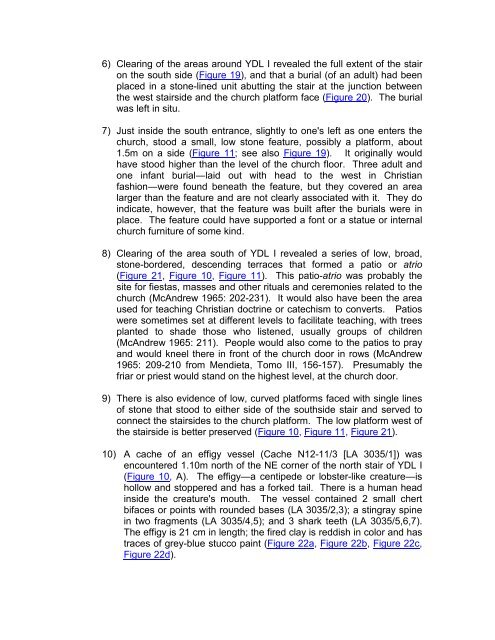Report submitted to FAMSI:
Report submitted to FAMSI:
Report submitted to FAMSI:
You also want an ePaper? Increase the reach of your titles
YUMPU automatically turns print PDFs into web optimized ePapers that Google loves.
6) Clearing of the areas around YDL I revealed the full extent of the stair<br />
on the south side (Figure 19), and that a burial (of an adult) had been<br />
placed in a s<strong>to</strong>ne-lined unit abutting the stair at the junction between<br />
the west stairside and the church platform face (Figure 20). The burial<br />
was left in situ.<br />
7) Just inside the south entrance, slightly <strong>to</strong> one's left as one enters the<br />
church, s<strong>to</strong>od a small, low s<strong>to</strong>ne feature, possibly a platform, about<br />
1.5m on a side (Figure 11; see also Figure 19). It originally would<br />
have s<strong>to</strong>od higher than the level of the church floor. Three adult and<br />
one infant burial―laid out with head <strong>to</strong> the west in Christian<br />
fashion―were found beneath the feature, but they covered an area<br />
larger than the feature and are not clearly associated with it. They do<br />
indicate, however, that the feature was built after the burials were in<br />
place. The feature could have supported a font or a statue or internal<br />
church furniture of some kind.<br />
8) Clearing of the area south of YDL I revealed a series of low, broad,<br />
s<strong>to</strong>ne-bordered, descending terraces that formed a patio or atrio<br />
(Figure 21, Figure 10, Figure 11). This patio-atrio was probably the<br />
site for fiestas, masses and other rituals and ceremonies related <strong>to</strong> the<br />
church (McAndrew 1965: 202-231). It would also have been the area<br />
used for teaching Christian doctrine or catechism <strong>to</strong> converts. Patios<br />
were sometimes set at different levels <strong>to</strong> facilitate teaching, with trees<br />
planted <strong>to</strong> shade those who listened, usually groups of children<br />
(McAndrew 1965: 211). People would also come <strong>to</strong> the patios <strong>to</strong> pray<br />
and would kneel there in front of the church door in rows (McAndrew<br />
1965: 209-210 from Mendieta, Tomo III, 156-157). Presumably the<br />
friar or priest would stand on the highest level, at the church door.<br />
9) There is also evidence of low, curved platforms faced with single lines<br />
of s<strong>to</strong>ne that s<strong>to</strong>od <strong>to</strong> either side of the southside stair and served <strong>to</strong><br />
connect the stairsides <strong>to</strong> the church platform. The low platform west of<br />
the stairside is better preserved (Figure 10, Figure 11, Figure 21).<br />
10) A cache of an effigy vessel (Cache N12-11/3 [LA 3035/1]) was<br />
encountered 1.10m north of the NE corner of the north stair of YDL I<br />
(Figure 10, A). The effigy—a centipede or lobster-like creature—is<br />
hollow and s<strong>to</strong>ppered and has a forked tail. There is a human head<br />
inside the creature's mouth. The vessel contained 2 small chert<br />
bifaces or points with rounded bases (LA 3035/2,3); a stingray spine<br />
in two fragments (LA 3035/4,5); and 3 shark teeth (LA 3035/5,6,7).<br />
The effigy is 21 cm in length; the fired clay is reddish in color and has<br />
traces of grey-blue stucco paint (Figure 22a, Figure 22b, Figure 22c,<br />
Figure 22d).
















